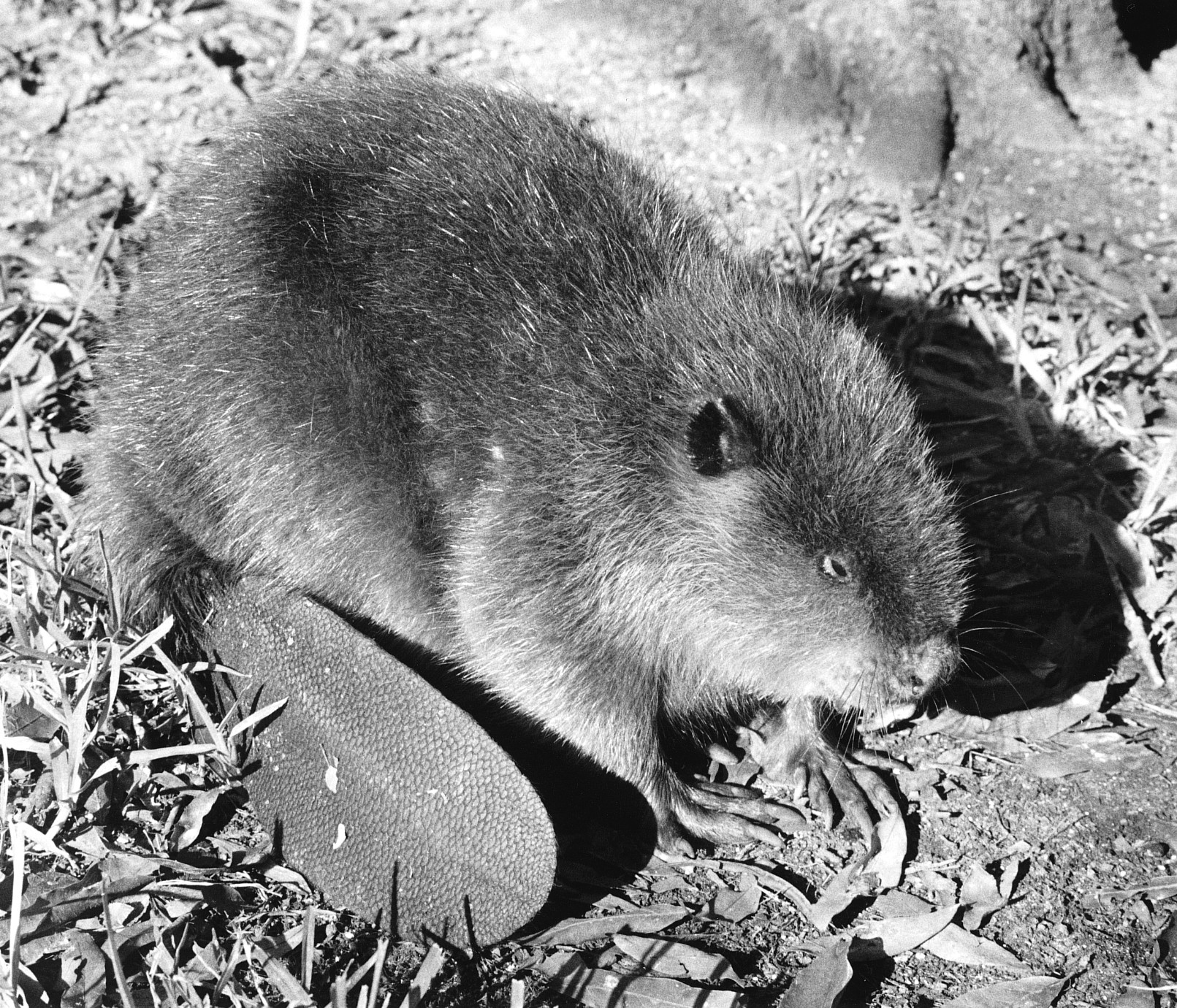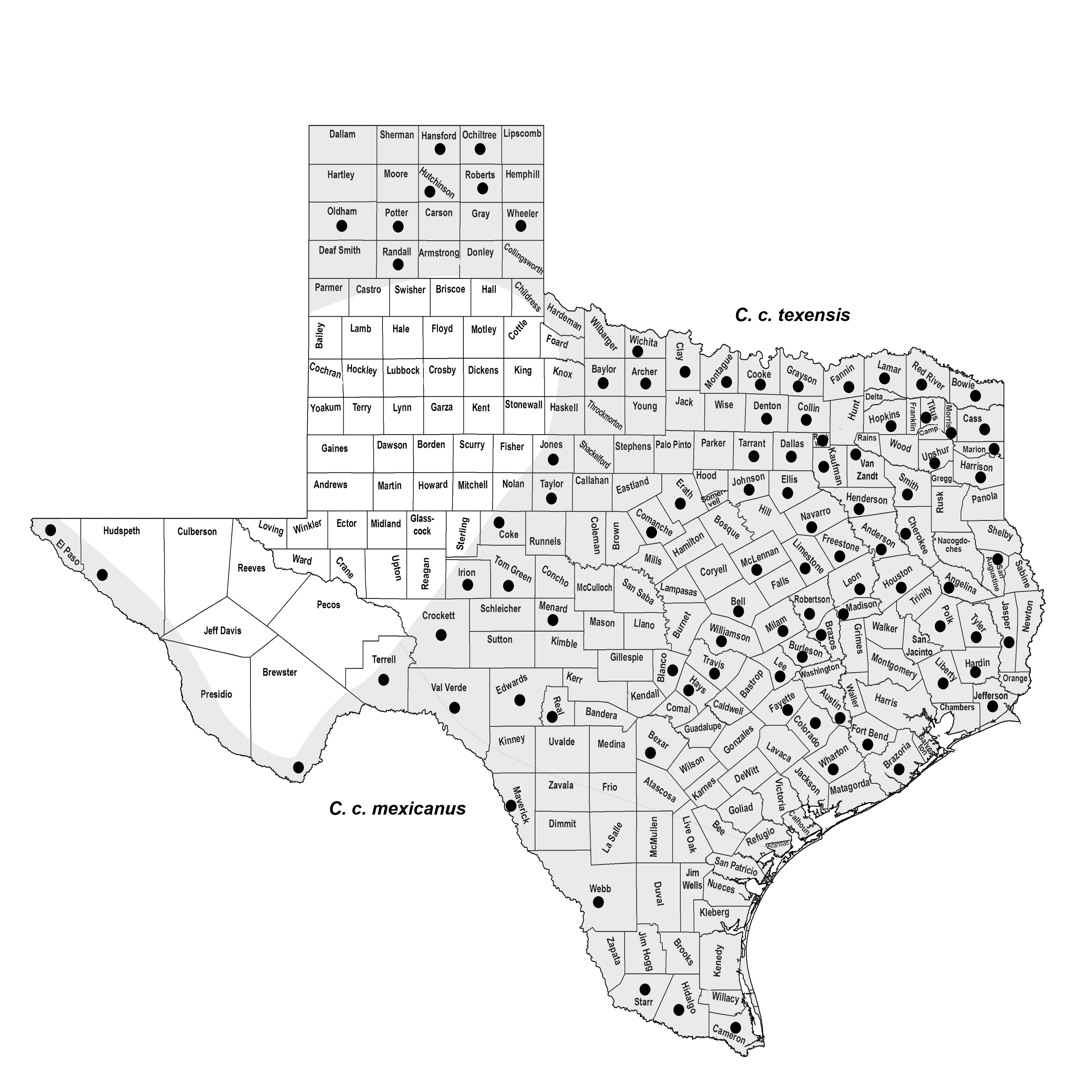AMERICAN BEAVER
Castor canadensis Kuhl 1820
Order Rodentia : Family Castoridae
DESCRIPTION. A large, robust, aquatic rodent with a broad, horizontally flattened, scaly tail; hind feet webbed; upperparts dark, rich, chestnut brown in early fall that fades by spring; underparts paler, often with silvery sheen. Sexes colored alike. Dental formula: I 1/1, C 0/0, Pm 1/1, M 3/3 × 2 = 20. Averages for external measurements: total length, 1,160 mm; tail, 400 mm; hind foot, 178 mm. Weight, averages 18 kg; rarely as much as 27 kg.

DISTRIBUTION. Found over most of the state where suitable aquatic habitat prevails. In the western part of its range it occurs in low density and local distribution, and it is absent from the Llano Estacado (except for Randall County) and some adjacent areas and from much of the Trans-Pecos.

SUBSPECIES. Castor c. mexicanus along the Rio Grande and its immediate tributaries and C. c. texensis to the north.
HABITS. Beavers are aquatic and require water in the form of a pond, stream, lake, or river. Because of their skills in regulating water level and stream flow with dams, beavers are able to convert an unfavorable area into one that is habitable. However, over time, their ponds tend to fill in with sediment and eventually become meadows, forcing the beavers to move to new sites. Large rivers and lakes offer suitable habitat in places where natural food and den or house sites are available, but the largest populations are on smaller bodies of water.
In cold regions, beavers live in houses (lodges) constructed of sticks and mud. Beavers enter and leave their lodge by means of underwater tunnels, or plunge holes. In Texas they may burrow into cut banks of streams or lakes. Burrows examined in the Rio Grande in the Big Bend section of Texas were nearly 0.75 m in diameter and ≥10 m in length. Burrows as long as 50 m (164 ft.) have been reported. Burrows, or houses, are used for loafing, sleeping, and rearing the young.
The average beaver colony consists of 6 or 7 animals, usually including parents and their young of two age classes; rarely is it as large as 12.
Beavers are obligate herbivores, feeding on the leaves, twigs, and bark of a variety of plants, especially the inner bark of willows and cottonwood trees. In summer, a number of herbaceous aquatic plants and sedges are eaten. In central Texas, where willows are absent, beavers in winter utilize as first choice such trees as button willow, juniper, and pecan; in summer they rely heavily on Bermuda grass, beard grass, ragweed, and yellow water lily. Along the Rio Grande, beavers seem to prefer willows (Salix spp.), although desert willow, mesquite, and tree tobacco also are consumed. Thus, the plants eaten and their order of preference depend in large measure on availability. The digestion of these woody materials is enhanced by a prominent cardiogastric gland in the stomach, glandular digestive areas elsewhere, and a large cecum containing cellulose-degrading microbes.
Breeding begins in January or February, and the young are normally born in May or June after a gestation period of about 107 days. Beavers are usually monogamous, and normally only one litter of three to four kits is produced each year, but some females produce a second litter in August or September.
At birth, the kits are fully furred, the eyes are open, and the incisor teeth are visible; they weigh about 450 g. The tail is broad and flat, as in adults. They grow rather slowly and attain a weight of about 10 kg the first year. They mature sexually the second year. Rarely, yearling females may breed and produce young. The young often stay with the family group through the second year.
Their value as soil and water conservationists is well known and, in most sections of the country, appreciated. They can be destructive to crops, trees, and irrigation systems, however, in which case they can be live-trapped and removed from the area.
POPULATION STATUS. Common. By the 1850s beaver were reduced to very low population numbers over a considerable part of Texas because of excessive annual harvests by trappers. However, these animals were able to survive along the remote streams of the upper and western Hill Country, along the Devil's River, along the edge of the Panhandle, and around El Paso. By the early 1900s they were found to be increasing in numbers, and shortly thereafter strict harvest regulations were imposed and restocking of depleted populations became common practice. Today, beaver are found over most of the state, especially in East Texas, where suitable aquatic habitat occurs.
CONSERVATION STATUS. The IUCN lists the American beaver as a species of least concern, and it does not appear on the federal or state lists of concerned species. Possible threats in the future include depletion of natural and human-made surface waters and competition with the introduced nutria. Overharvesting is no longer a serious threat.
From The Mammals of Texas, Seventh Edition by David J. Schmidly and Robert D. Bradley, copyright © 1994, 2004, 2016. Courtesy of the University of Texas Press.
Natural Science Research Laboratory
-
Address
Museum of Texas Tech University, 3301 4th street, Lubbock, TX 79409 -
Phone
806.742.2486 -
Email
nsrl.museum@ttu.edu

